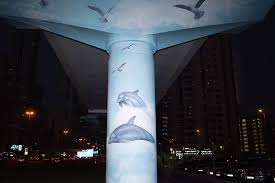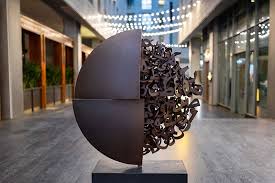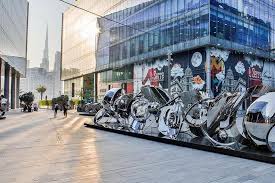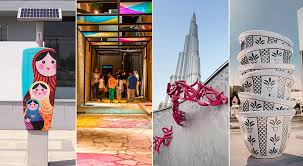The Rise of Art Beyond Museum Walls
Dubai has long been associated with futuristic skyscrapers, luxury shopping, and world-class hospitality. But in recent years, the city has been quietly reinventing itself as a cultural hub—one where art is not confined to museums or exclusive galleries, but woven into the fabric of everyday life. Murals stretch across building facades, sculptures rise in public plazas, and entire neighborhoods pulse with creative energy. What was once a desert landscape has become a vibrant, open-air gallery, welcoming both residents and visitors to experience art in the most unexpected places.
This shift has been intentional. Dubai’s leadership and creative community have invested in making the city more accessible through art, allowing culture to thrive on the streets. For many, this accessibility is what makes Dubai’s art scene feel alive and inclusive.
Murals That Speak to the City
One of the most striking transformations can be seen in Dubai’s street art. Neighborhoods once known only for their commercial buzz now host large-scale murals that celebrate heritage, diversity, and imagination. In areas like Jumeirah, Karama, and City Walk, walls have become canvases where international and local artists leave their mark.

These murals are more than visual beauty—they are storytellers. Some capture the UAE’s deep-rooted Bedouin traditions, while others highlight the multicultural essence of Dubai, reflecting the voices of the city’s diverse population. For young people growing up here, this art feels relatable, breaking away from the formality of gallery spaces. It’s not just art you look at; it’s art you walk past on your way to work, art you pause to photograph, and art that sparks conversations.

Public Sculptures That Redefine Space
While murals bring walls to life, sculptures have taken over Dubai’s open spaces. Across the city, monumental installations rise in parks, plazas, and along waterfronts. Whether it is abstract forms, cultural symbols, or contemporary interpretations, these sculptures add character and identity to the city’s urban design.

Downtown Dubai, for example, is dotted with sculptures that stand against the backdrop of the Burj Khalifa. The contrast of steel and stone artworks with glass towers symbolizes how tradition and modernity coexist in the city. Public parks like Zabeel and Safa now feature installations that invite families and children to interact with them, turning an ordinary day outdoors into an artistic experience.
These sculptures also redefine how people use space. They encourage lingering, reflection, and photography, transforming otherwise functional areas into destinations for creativity and leisure.
The Emergence of Sculpture Parks
Dubai has gone a step further by dedicating entire spaces to art in nature. Sculpture parks are among the city’s most exciting developments, offering curated outdoor experiences where creativity and environment blend seamlessly. Unlike traditional galleries, these parks invite people to wander freely, engaging with large-scale works that stand against the desert sky or amid carefully landscaped gardens.
The concept of the sculpture park resonates deeply with Dubai’s ethos. It is both futuristic and accessible—a chance to showcase bold artistic visions while making them open to everyone. Visitors no longer need a ticket to an exclusive museum; they can walk through a park and encounter art that inspires, educates, and uplifts.

Art Districts Breathing New Life into Communities
Beyond murals and sculptures, entire districts have embraced the open-air gallery concept. Places like Alserkal Avenue, once industrial zones, have been reimagined into thriving creative neighborhoods. While Alserkal houses galleries and studios, its outdoor spaces often double as exhibition grounds for large installations and performances.
Other areas, like La Mer and JBR, integrate art into their leisure environments. Strolling along the beach or dining at a café is no longer just about food or scenery—it’s about being surrounded by artistic expressions that enhance the experience. This integration reflects Dubai’s vision of lifestyle and culture as inseparable.
Making Art Accessible to Everyone
What makes Dubai’s open-air gallery movement unique is its accessibility. Not everyone feels comfortable walking into a traditional art gallery. But when art is in your daily path—on walls, in parks, or near metro stations—it becomes something you naturally engage with.
Families out on a weekend picnic stumble across sculptures they can touch. Children see giant murals and ask questions about their meaning. Tourists, who may have come for luxury shopping, find themselves captivated by a side of Dubai they didn’t expect—one that is soulful, expressive, and deeply human.
This democratization of art builds a stronger cultural identity for the city. It reminds people that creativity is not reserved for the elite; it belongs to everyone.
Art as a Reflection of Dubai’s Vision
The open-air gallery movement is not just about aesthetics—it is a reflection of Dubai’s larger vision. The city has always positioned itself as forward-thinking, and its embrace of public art reinforces that identity. It shows a commitment to nurturing creativity alongside commerce, beauty alongside technology.
By encouraging public art, Dubai also strengthens its global reputation as a cultural capital. Just as New York is known for its street murals or Paris for its sculptures, Dubai is carving its own artistic identity—one that fuses modern innovation with cultural pride.

The Emotional Impact of Public Art
Beyond strategy and urban planning, there is something deeply emotional about encountering art in everyday life. A mural might brighten someone’s morning commute. A sculpture might spark curiosity in a child. A public installation might provide comfort, reminding people that creativity exists even in concrete spaces.
For residents, these artworks create a sense of belonging. For visitors, they offer a fresh perspective of Dubai—one that goes beyond the clichés of luxury and skyscrapers. For artists, the city becomes a canvas where their work can reach thousands daily.
Looking Ahead: Dubai as a Living Museum
The journey from street art to sculpture parks is only the beginning. Dubai’s vision continues to expand, with more projects and cultural initiatives on the horizon. The future promises not just more art, but more interaction, collaboration, and innovation.
The idea of a living museum—a city where every corner tells a story through creativity—is slowly becoming reality. As art continues to spill into the streets, parks, and public squares, Dubai strengthens its identity as a place where culture is not just celebrated but lived.

Conclusion: A City That Inspires Through Creativity
Dubai’s transformation into an open-air gallery is more than an artistic movement—it is a cultural revolution. By bringing art out of traditional spaces and into everyday life, the city is making creativity accessible, engaging, and inspiring.
From vibrant street murals to awe-inspiring sculpture parks, Dubai has redefined what it means to experience art. It is no longer about stepping into a gallery; it is about stepping into the city itself. Every street, every park, every plaza becomes a canvas, turning Dubai into a place where art lives, breathes, and belongs to everyone.
Do follow UAE Stories on Instagram
Discover 5 Magical Dubai Restaurants That Feel Like the Night Sky















